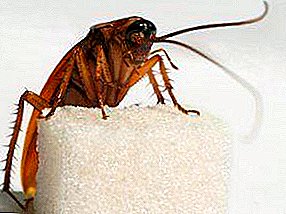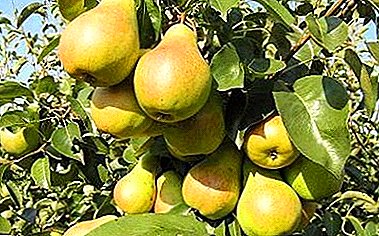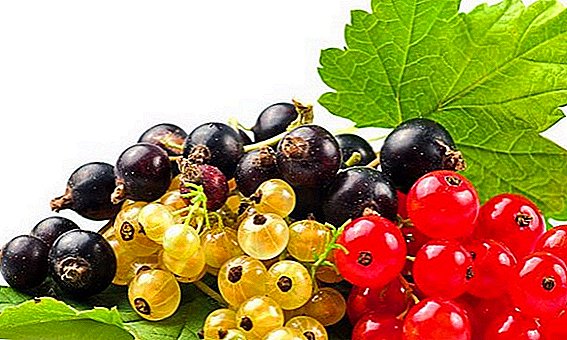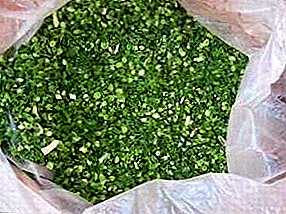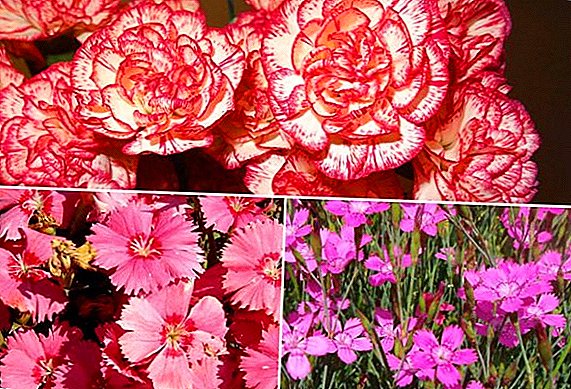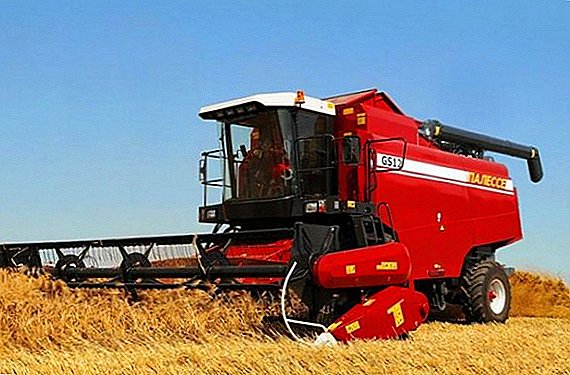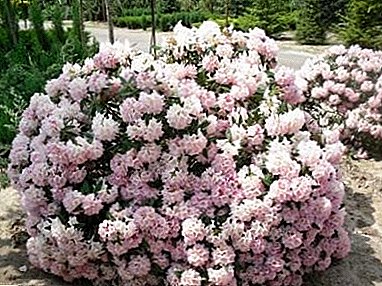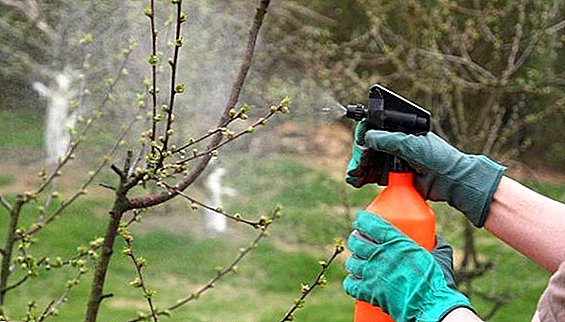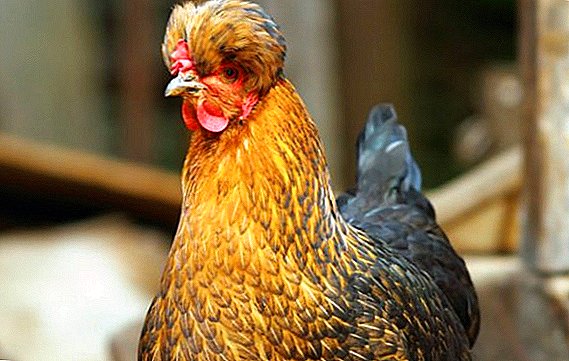 Today, breeders offer for breeding a variety of different breeds of domestic chickens, which are distinguished by their demands on the conditions of detention, indicators of productivity and reproduction, as well as by purpose (meat breeds or layers). Among this variety, there is one breed that has especially fallen in love with the poultry farmers, the Russian crested. Let's take a closer look at this poultry and find out why it is most often given priority.
Today, breeders offer for breeding a variety of different breeds of domestic chickens, which are distinguished by their demands on the conditions of detention, indicators of productivity and reproduction, as well as by purpose (meat breeds or layers). Among this variety, there is one breed that has especially fallen in love with the poultry farmers, the Russian crested. Let's take a closer look at this poultry and find out why it is most often given priority.
A bit of history
By methods of national selection many breeds of domestic hens are bred. It is to them that the Russian crested hen, which appeared at the end of the 19th century on Russian peasant farmsteads due to repeated spontaneous crossing, can be attributed. The result was a hardy to cold weather breed, which is also meat and egg, that is, universal. There is another version of the interpretation of the origin of this species: their ancestors were birds originally from Asia. Despite the active disputes of breeders on this topic, the final conclusion on this issue has not been made.
Did you know? With its number, domestic chickens outnumber the number of all people on Earth: their ratio is three to one.
Characteristics and features
The main external difference between Russian crested chickens and other species of domestic birds is their lush tuft on top of head. These are birds with a harmoniously developed, not large body, non-feathered legs and with a variety of colors. Now let us dwell on the classic description of Russian crested chicken and tell you about the external characteristics of the breed, the nature of pets, productivity and ability to hatch. 
Appearance
Crested chickens have a rather attractive and original appearance:
- Elongated head with red skin, topped with bright red, not very high leaf-like or rose-like comb, well developed red earrings and earlobes with white specks.
- Tufts can be of different shapes: sprawling, round, sheaflike, helmet-shaped or protruding. They originate from the nose and descend to the back of the head.
- The eyes may be yellow, red-orange or brown, depending on the color of the plumage.
- Strong, slightly curved and long beak with color from yellow to almost black.
- The body is elongated, tapering towards the tail, with a convex muscular chest.
- The neck is gracefully arched, in the form of a cone.
- The back of the bird is straight and wide.
- Straight set feather-rich tail.
- Slightly lowered large wings.
- Strong short legs without plumage.
- Feathers thick and densely knocked down.
Read also about the Chinese silk, Hungarian giant, Kuban red, Poltava, Adler silver rocks.
Rooster and chicken: the differences
There are no big differences between females and males in Russian crested chickens, but nevertheless some features are characterized by sexual characteristics.  Chickens:
Chickens:
- have a thicker, denser, and lush tuft that periodically needs to be trimmed;
- the body is slightly smaller in size than in males;
- half as large as a cock;
- tummy contoured;
- weight from 2 to 2.5 kilograms;
- high pubescent tail without long feathers.
Roosters:
- crest of smaller size and pomp than females;
- there is a feather mane;
- the body is larger and more powerful than that of the chickens;
- males weigh from 3 to 3.5 kilograms;
- the tummy is a little picked up;
- high set triangular-shaped lush tail with long, curved at the end of the braids.
Did you know? Rooster sperm has a prolonged effect, so that during one mating several dozen eggs can fertilize for 3-4 weeks.
Color
The color of the crested bird is diverse. The standards allow both smooth and spotty colors, as well as multi-colored in any combination:
- whites;
- silvery;
- fawn;
- black
- brown;
- blue;
- chintz;
- gray
- red;
- salmon;
- black and gold;
- silvery black;
- cuckoo
 If crested chickens have white plumage, then according to the standard it should not give off yellowness. Also, males with blue color mane and tail tail feathers should be black.
If crested chickens have white plumage, then according to the standard it should not give off yellowness. Also, males with blue color mane and tail tail feathers should be black.
Character
By the nature of this contact and non-aggressive domestic chickens that are not afraid of a person and easily tamed. Aggression is observed only in relations between males.
Puberty and egg production
The young crested chickens begin to rush from 5-6 months of age, and they produce 150 to 190 eggs per year. The average weight of each egg is 56 grams. Maximum egg production is achieved in the first 1.5 years of life, then this ability gradually decreases.
Read also about the period of egg production in pullets and vitamins for laying hens.
Hatching instinct
Russian crested have by nature amazing parenting skills: broods are happy to sit down for incubation, and then become caring chews for newborn chickens. Therefore, there is no urgent need for artificial incubators. 
Conditions of detention
Despite the fact that this breed is unpretentious, in order to achieve high results in productivity, as well as for a high percentage of survival in a temperate and cold climate, the hens of this species require optimal conditions for their housing.
It is necessary to consider the following nuances:
- A properly constructed coop with lighting is required.
- In addition to perches, there should be organized floor content and a suitable covering for it.
- Free range in an open-air cage under a canopy at any time of the year (except for severe frosts).
- Proper organization of air exchange inside the hen house.
- The construction of suitable drinkers and feeders.
Now we will discuss in detail some important points from the list above.
Tips for beginner poultry farmers: learn how to build a nest and roost for laying hens.
Coop Requirements
As already mentioned, their life and health depend on the conditions of chickpea keeping, so they need a comfortable hen house.
Important! Wild animals can penetrate into the coop without a proper foundation by digging under the walls. To prevent this from happening, you need to dig around the perimeter of the building sheets of iron or a netting chain to a depth of at least 50 centimeters.
 Here are the requirements for its construction and equipment:
Here are the requirements for its construction and equipment:
- It is necessary to locate the chicken coop at a sufficient distance from people's housing, so that unpleasant smells from the vital activity of the pet would not annoy.
- It is necessary to build housing for chickens on a high place of the site so that you can avoid flooding during seasonal rains and floods.
- It is necessary to build a capital structure with a concrete foundation, it is desirable to build walls of wood so that the house is safe, warm and spacious, in which a sufficient number of water troughs, feeders, perches and nests can freely accommodate.
- Nests must be placed in easily accessible places, slightly shaded.
- Be sure to line the bottom of the nest with a bed of hay or wood chips.
- House dimensions for chickens should be correlated with the number of poultry: for families up to 20 individuals suitable room 2x3 meters, and with a larger number - in the calculation of 6 square meters for every 20 goals.
- The floor is built of wood: it must be insulated, with a bed of hay, straw, wood shavings or sawdust.
- Perches made of timber (section of at least 4 to 6 cm). Their height from the floor should be from 30 to 60 centimeters.
- Must be remembered sanitary standards: remove contaminated litter in time so that there is no increased humidity in the room and reproduction of pathogens.
- Specially organize heating in the hen house is not necessary. It is enough to equip the warmed doors and make sure that there are no holes blown through the walls.
- Good time for winter lighting inside the chicken coop so that the hen egg production does not fall when it gets dark early enough. It will also provide additional heating for the room.
- Good ventilation inside the hen house is needed.
- Inside the room you need to arrange containers with sand with the addition of wood ash for bathing birds.
Learn more about home improvement for chickens: choosing and buying a chicken coop, self-production and home improvement of a chicken coop.
Walking yard
Indoor canopy and courtyard for walking poultry - mandatory attributes of the content of crested birds. Therefore, it is important that:
- the site should be spacious enough, fenced mesh with cells of small diameter;
- the bottom of the net must be dug in to the ground so that the birds would not be able to get out into the yard, and also that predators could not dig;
- canopy can be covered with slate or the same grid.

Feeders and drinkers
To maintain cleanliness inside the chicken coop, as well as to keep pets from getting dirty and their feathers wet, troughs and drinkers should be properly organized.
Here are some requirements for their placement:
- Drinking bowls and feeders for poultry should be appropriate to the number of livestock, their size and age.
- Tanks must be cleaned easily and disinfected regularly.
- Metal or plastic containers are better suited for wet food (mash), and wooden for dry food.
- Drinking bowls should be placed both in the hen house and on the walk. They must always be filled.
Important! The amount of water consumed per day by one chicken may vary depending on the type of feed and the temperature conditions inside the chicken coop. For example, when the air temperature is about +19° С, the chicken will drink about 300 milliliters of liquid per day.
How to endure the winter cold
We have already mentioned that the Russian crested breed of chickens is resistant to cold and can feel great at low temperatures typical of our latitudes. If the pets have a well-insulated and properly equipped chicken coop, they will not be afraid of the winter cold.  The only thing you need to remember - do not release poultry into the walking yard at temperatures below -40 ° C. At lower temperatures, the chickens can easily walk in the fresh air for 30-60 minutes a day without the risk of freezing their beautiful earrings and scallops protected by lush feathers.
The only thing you need to remember - do not release poultry into the walking yard at temperatures below -40 ° C. At lower temperatures, the chickens can easily walk in the fresh air for 30-60 minutes a day without the risk of freezing their beautiful earrings and scallops protected by lush feathers.
Find out what to do if chickens do not carry well, carry small eggs, peck eggs.
Moult
Molting in poultry is a natural process that occurs in healthy individuals without any particular difficulties. During this period, their egg production decreases. Therefore, it is important to monitor their health year-round, and within 2 months from the start of the seasonal molt, your pets will have a new beautiful plumage and will restore their egg-laying.
Did you know? Chickens are carried only in good light. If it is already time to fly, and it is dark on the street or in the hen house, then the layer is able to postpone the time for laying eggs until dawn or until the lights come on.
What to feed adults
The menu for an adult family should consist of nutritious foods with plenty of vitamins and calcium.
Here are the recommendations for their diet:
- If you feed the crested hen grains, they must be varied. Best suited ready feed.
- For the decorative look of your pets, as well as maintaining immunity in their diet should be fish oil.
- Both in summer and in winter, there should be green in the feed. For the winter ration, greens are harvested during the warm season: dried green mass is dried, ground into flour and stored in a dry place. In this feed, nutrients are stored up to 90%.
- Wet mash must be given year round. In winter, it is advisable to offer it to the bird in the form of heat so that the feathered family can additionally warm during the absorption of food, and the porridge does not have time to freeze.
- In the shed you can install a container of sand, small gravel and shell - this will be an additional source of mineral supplements and contribute to the better work of the stomach in pets.

Important! So that chickens, as well as adults, do not have stomach diseases, a weak solution of potassium permanganate should be added to the drinkers twice a week.
Breeding chicks
Since Russian crested hens have a well-developed incubation instinct, it is easy to breed them at home. The first egg-laying can be organized already in the fifth or sixth month of life, if you have provided your hen with the proper care and nourishment. Usually, 80-90% of the chickens hatch. Consider what is needed for this.
Get acquainted with the breeds of chickens meat, egg, meat, egg, decorative direction.
Incubation
The prerequisites for chicks hatching are created by the females themselves in the spring: at this time of the year, their brood instinct is especially developed. This time is the best because the young hatching will grow in the warm season.
When a hen begins to whimper, linger in the nest and pluck down and feathers for laying the nest, then in 3-4 days it will be possible to put the necessary number of eggs suitable for breeding chickens under it. The incubation period lasts 21 days. During this time, the hen needs full food and drink. The hen can sit for a long time in the nest on the eggs without leaving them, so sometimes it is necessary to forcibly remove the hen from the nest and give it the opportunity to refresh itself.  Homemade incubators can also be used for breeding Russian crested offspring.
Homemade incubators can also be used for breeding Russian crested offspring.
Did you know? The hen instinctively feels when there are dead embryos in the clutch: it can roll back such an egg or bury it separately in a nest.
Care for the young
After the twenty-first day of the beginning of the incubation, chickens begin to appear one after the other. Your actions:
- From the first hours and days, the young can be left with the "mother". Warmed by her warmth, they quickly dry out and begin to lead an active lifestyle, everywhere following their parent.
- It is also permissible to remove hatched chicks and place them separately in boxes and boxes well lit from above and warmed up from below.
- The bottom of the boxes and boxes of young animals should always be covered with a clean and dry bedding. Inside the box, the temperature should be optimal, +30 degrees, because chicks are very sensitive to temperature fluctuations and drafts.
- Make sure that the chickens always have warm and clean water in their pots. It is desirable that the drinkers have such a structure, when using which the chicks would not wet their paws and tummies.
From the first days of life, chickens should receive proper and well balanced nutrition. 
Chicken Diet
The very first feed for hatched chickens should be the following products:
- Millet and hard-boiled and knife-shredded egg with the addition of shredded sprigs of young fennel. In the form of drinking should be fresh water or fresh broth hips and chamomile. Such a diet should be in the first two weeks of life.
- From the 14th day and up to one and a half months, you can add finely ground semolina and corn grits to the egg, as well as cottage cheese, greens, and vegetable mash with shrimp. On the walking chicks will look for small insects.
- From one and a half to four and a half months in chicks, an active growth of muscle mass is observed, therefore in feeding it is necessary to focus on protein products: feed with proteins, sour milk and cottage cheese, mash on meat broth.
- During puberty of young stock, mineral supplements, protein, vitamins from vegetables and greens predominate in the diet, so that the first eggs can properly form.
Did you know? Incubators for eggs used in ancient Egypt for 1500 years BC. er At that time only temple priests were engaged in breeding birds, arranging huge incubators in the form of thick-walled barrels with several tens of thousands of eggs. The desired temperature was maintained with the help of clay pots with a liquid that solidified at a certain temperature. If this happened, then the temperature was regulated by burning straw, - this was used to heat the thick walls, which then gently gave off heat.
Herd replacement
Above, we cited the average annual indicator of the productivity of Russian crested hens. These figures apply only to chickens up to the age of three. Although the chicken can live up to 10 years, after a three-year period of active egg production, it will no longer be productive.
Therefore, a planned replacement of livestock is carried out after two or three years. Considering that the chickens of this breed have a high survival rate, when the “old” chickens are slaughtered, the livestock can quickly recover. 
The breed's tendency to disease
Russian crested chicken has a strong natural immunity, therefore its resistance to infections is compared with resistance to diseases in wild birds. But if, when keeping them in a hen house, neglect sanitary and hygienic norms, then chickens can become infected from a source of infection that is in sewage. In addition to constant cleaning and good ventilation in the hen house, for preventive purposes, chickpeas should be periodically added chamomile broth for drinking.
Learn more about the treatment of diseases of chickens: diarrhea, pasteurellosis, coccidiosis, colibacteriosis.
Advantages and disadvantages
It can be said that this poultry has much more advantages than possible disadvantages.
Advantages:
- high productivity and hatchability;
- tasty and nutritious meat;
- strong immunity;
- decorative appearance;
- endurance to low temperatures;
- calm and livable temper;
- good contact with the person;
- developed maternal instinct;
- simple maintenance and care.
Disadvantages:
- the aggressiveness of males in relation to each other;
- extra trouble to the owner when you need to constantly trim the growing tuft.
We advise you to read about the differences and the maintenance of the breeds and crosses of chickens: bielefelder, Pavlovskaya, Haysex, Hubbard, Amrox, Maran, Master Gray, Dominants, Broan Brown, Redbro, Viandot, Black Bearded, Fireball, Riddles.
Video: Russian crested breed of chickens
As can be seen from the above, Russian crested chicken is an unpretentious poultry that has high productivity, decorative appearance and high-quality meat and eggs. In addition, the breed's resistance to extreme weather conditions and simplicity in its content will please both breeders and experienced breeders.


